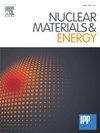Investigation of island size effect on radiation distribution during attached and detached plasmas in the island divertor of W7-X
IF 2.3
2区 物理与天体物理
Q1 NUCLEAR SCIENCE & TECHNOLOGY
引用次数: 0
Abstract
Mitigation of heat on the first wall through divertor operation is a key to a successful future fusion reactor. W7-X employs an island divertor to control the exhaust and heat load on the plasma impacting divertor plates. Increased radiation in the divertor reduces the heat load at the plasma contact point during detachment. In this paper we investigate the distribution of the radiation using an InfraRed imaging Video Bolometer (IRVB) that views the divertor region in two dimensions giving information on both the poloidal and toroidal variation of the radiation in comparison to conventional resistive bolometer arrays that typically only give poloidal variation information. Experiments were carried out using a standard magnetic configuration modified by changing control and planar coil currents to achieve three different island sizes without changing the strike line location. For each island size low and high density (ne = ∼4 and ∼ 7 x 1019/m3, respectively) plasmas were created with ∼ 2 MW of ECH input power, which correspond to attached and detached plasmas with radiated power fractions (frad) of ∼ 20–25 % and ∼ 90 %, respectively.
Results indicate an increase in density led to an increase in the IRVB radiation signals as seen in the total radiated power (and frad) and a slight broadening in the signals indicating less radiation from the target locations, especially the lower right location in the IRVB field of view when compared with the corresponding thermography images. However, no noticeable difference in the IRVB radiation pattern or intensity is seen with the change of the island size.
求助全文
约1分钟内获得全文
求助全文
来源期刊

Nuclear Materials and Energy
Materials Science-Materials Science (miscellaneous)
CiteScore
3.70
自引率
15.40%
发文量
175
审稿时长
20 weeks
期刊介绍:
The open-access journal Nuclear Materials and Energy is devoted to the growing field of research for material application in the production of nuclear energy. Nuclear Materials and Energy publishes original research articles of up to 6 pages in length.
 求助内容:
求助内容: 应助结果提醒方式:
应助结果提醒方式:


